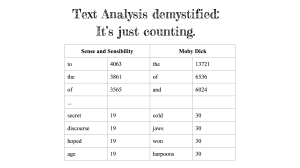This post originally appeared on the Digital Humanities at Berkeley blog. It is the second in what became an informal series. Images have been included in the body of this post, which we were unable to originally. For a brief reflection on the development of that project, see the more recent post, Reading Distant Readings.
Computer reading can feel like a Faustian bargain. Sure, we can learn about linguistic patterns in literary texts, but it comes at the expense of their richness. At bottom, the computer simply doesn’t know what or how words mean. Instead, it merely recognizes strings of characters and tallies them. Statistical models then try to identify relationships among the tallies. How could this begin to capture anything like irony or affect or subjectivity that we take as our entry point to interpretive study?
I have framed computer reading in this way before – simple counting and statistics – however I should apologize for misleading anyone, since that account gives the computer far too much credit. It might imply that the computer has an easy way to recognize useful strings of characters. (Or to know which statistical models to use for pattern-finding!) Let me be clear: the computer does not even know what constitutes a word or any linguistically meaningful element without direct instruction from a human programmer.
In a sense, this exacerbates the problem the computer had initially posed. The signifier is not merely divorced from the signified but it is not even understood to signify at all. The presence of an aesthetic, interpretable object is entirely unknown to the computer.
Teasing out the depth of the computer’s naivety to language, however, highlights the opportunity for humanists to use computers in research. Simply put, the computer needs a human to tell it what language consists of – that is, which objects to count. Following the description I’ve given so far, one might be inclined to start by telling the computer how to find the boundaries between words and treat those as individual units. On the other hand, any humanist can tell you that equal attention to each word as a separable unit is not the only way to traverse the language of a text.
Generating instructions for how a computer should read requires us to make many decisions about how language should be handled. Some decisions are intuitive, others arbitrary; some have unexpected consequences. Within the messiness of computer reading, we find ourselves encoding an interpretation. What do we take to be the salient features of language in the text? For that matter, how do we generally guide our attention across language when we perform humanistic research?
The instructions we give the computer are part of a field referred to as natural language processing, or NLP. In the parlance, natural languages are ones spoken by humans, as opposed to the formal languages of computers. Most broadly, NLP might be thought of as the translation from one language type to another. In practice, it consists of a set of techniques and conventions that linguists, computer scientists, and now humanists use in the service of that translation.
For the remainder of this blog post, I will offer an introduction to the Natural Language Toolkit, which is a suite of NLP tools available for the programming language Python. Each section will focus on a particular tool or resource in NLTK and connect it to an interpretive research question. The implicit understanding is that NLP is not a set of tools that exists in isolation but necessarily perform part of the work of textual interpretation.
I am highlighting NLTK for several reasons, not the least of which is the free, online textbook describing their implementation (with exercises for practice!). That textbook doubles as a general introduction to Python and assumes no prior knowledge of programming.[1] Beyond pedagogical motivation, however, NLTK contains both tools that are implemented in a great number of digital humanistic projects and others that have not yet been fully explored for their interpretive power.
Continue reading →

